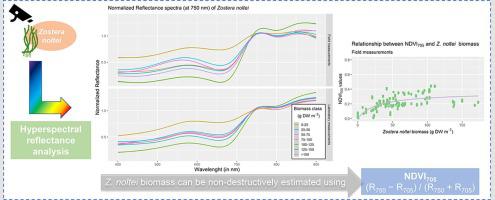Ecological Indicators ( IF 7.0 ) Pub Date : 2020-10-12 , DOI: 10.1016/j.ecolind.2020.107018 Valentina Costa , João Serôdio , Ana I. Lillebø , Ana I. Sousa

|
Seagrasses are marine plants ranked worldwide amongst the most valuable coastal ecosystems. The global conservation effort requires accurate estimation of seagrass abundance and taxonomic composition. Hyperspectral reflectance has been used to estimate seagrass biomass, despite requiring destructive laboratory measurements that goes against conservation principles.
Therefore, we assessed the efficiency of Zostera noltei hyperspectral reflectance to estimate its aboveground biomass in intertidal areas, having Ria de Aveiro coastal lagoon (Portugal) as a case study, with seasonal samplings during a whole year comparing (non-destructive) field- and (destructive) laboratory-based measurements of the spectral signature. Several vegetation indices (VIs) that focus on the spectral absorption of specific pigments were also tested: Normalized Difference Vegetation Indices (NDVI)-like ratios, Double Difference (DD)-like Ratios and Simple Ratios (SR).
Here we show that Z. noltei hyperspectral signature, measured in the field and in the laboratory, is clearly related to the aboveground biomass of the plant along the year. We found that among the VIs, NDVI-like ratios showed higher correlation with Z. noltei aboveground biomass than the other types of VIs. Taking into consideration the sensitivity to biomass saturation, the NDVI705 was identified as the best vegetation index to estimate Z. noltei biomass during the whole year and in both type of measurements, up to a saturation level, also demonstrating the successful use of non-destructive methods.
The suitability of hyperspectral reflectance measurements in order to estimate Z. noltei aboveground biomass was confirmed, confirming also the potential efficient use of field-based measurements (non-destructive) for conservation practices and sustainable management of the species in intertidal ecosystems and allowing aboveground biomass to be potentially proposed as a metric for the evaluation of seagrass healthy condition under EU policies (e.g. Water Framework Directive, Marine Strategy Framework Directive).
中文翻译:

利用高光谱反射率非破坏性地估算海草Zostera noltei生物量
海草是在全球最有价值的沿海生态系统中排名最高的海洋植物。全球保护工作要求准确估计海草丰度和生物分类组成。尽管要求进行破坏性的实验室测量而违反保护原则,但高光谱反射率已用于估计海草的生物量。
因此,我们以Ria de Aveiro沿海泻湖(葡萄牙)为案例研究,评估了Zostera noltei高光谱反射率在潮间带的地上生物量的效率,并以全年的季节性采样比较了(无损)田间和野外采光。(破坏性)基于实验室的光谱特征测量。还测试了几种专注于特定颜料光谱吸收的植被指数(VI):归一化植被指数(NDVI)式比率,双差(DD)式比率和简单比率(SR)。
在这里,我们显示在野外和实验室中测量的Z. noltei高光谱特征显然与一年中植物的地上生物量有关。我们发现,在VI中,类NDVI比率与No. zept。noltei地上生物量的相关性高于其他类型的VI。考虑到对生物量饱和度的敏感性,NDVI 705被认为是估计全年和两种测量方式中的诺氏Z生物量的最佳植被指数,直至达到饱和水平,也证明了非植被的成功使用。破坏性的方法。
证实了高光谱反射率测量值适用于估算诺氏Z在地上生物量的可能性,也证实了潜在有效利用田间测量(非破坏性)进行潮间带生态系统物种保护和可持续管理并允许地上生物量有可能被提议作为评估欧盟政策(例如,水框架指令,海洋战略框架指令)中的海草健康状况的指标。











































 京公网安备 11010802027423号
京公网安备 11010802027423号